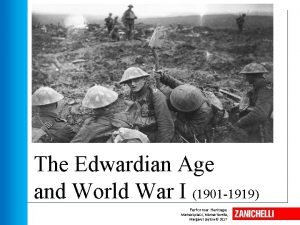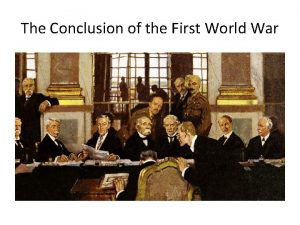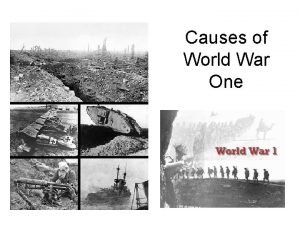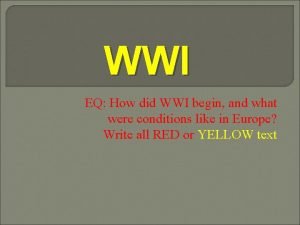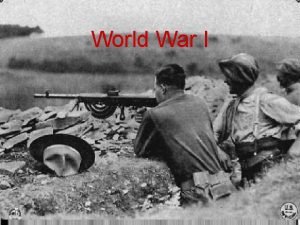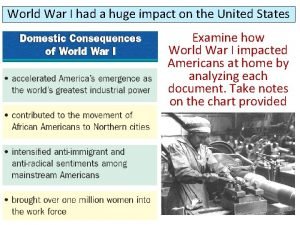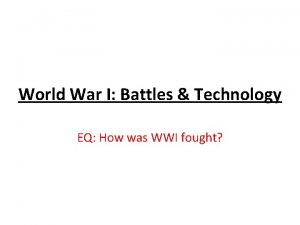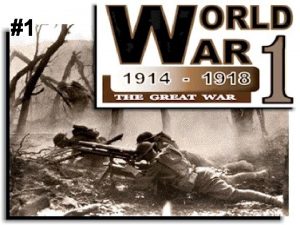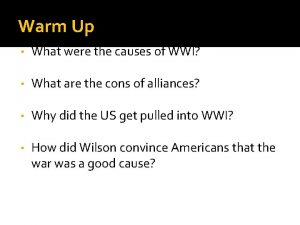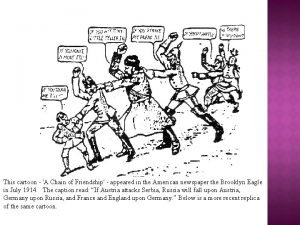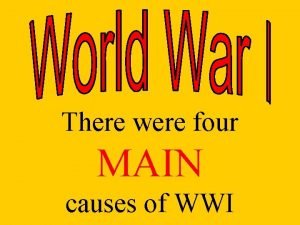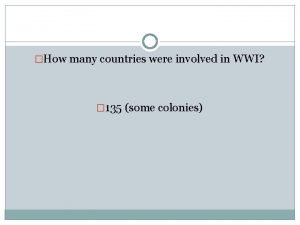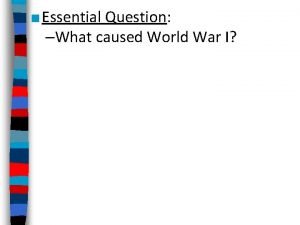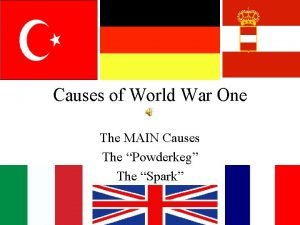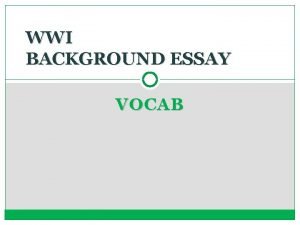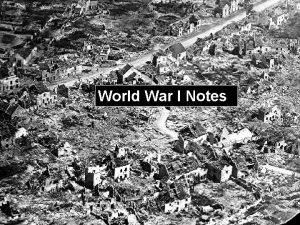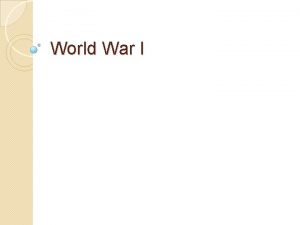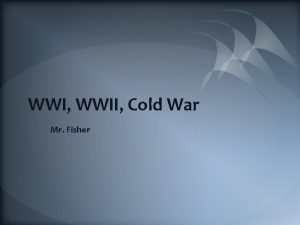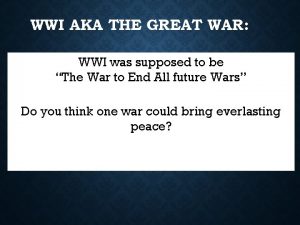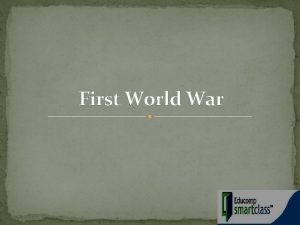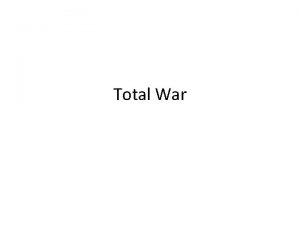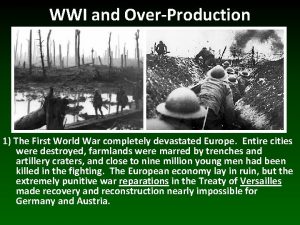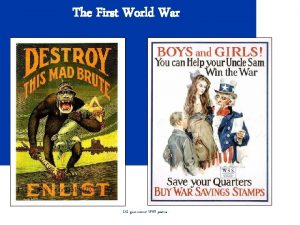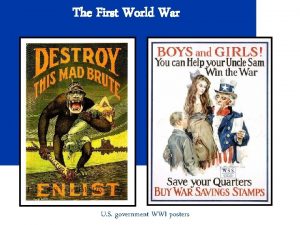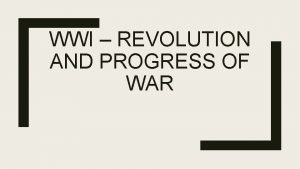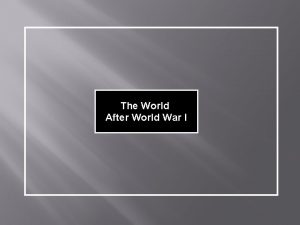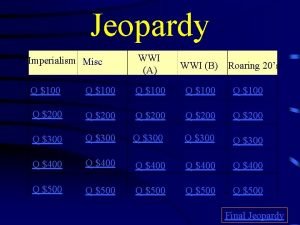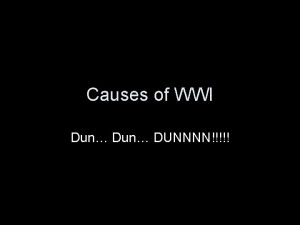WORLD WAR I WWI The First World War









![The Major Players: 1914 -17 Allied Powers: Central Powers: Nicholas II [Russia] Wilhelm II The Major Players: 1914 -17 Allied Powers: Central Powers: Nicholas II [Russia] Wilhelm II](https://slidetodoc.com/presentation_image_h2/aad4c08bab0571fed3760ea924b31a48/image-10.jpg)










- Slides: 20

WORLD WAR I (WWI)

The First World War: What? • War involving nearly all the nations of the world • When? • 1914 -1918 2

Cont… • Why? Long term causes: 1. Militarism 2. Alliance system 3. Imperialism 4. Nationalism Franz Ferdinand, Archduke of Austria and his Wife Sophie, Duchess of Hohenberg one hour before their deaths, June 28, 1914. The assassination was the spark that ignited the war. Short term cause: Assassination of Franz Ferdinand of the Austro. Hungarian Empire

Biography • Franz Ferdinand (18 December 1863 – 28 June 1914) was an Archduke of Austria-Este, Austro -Hungarian and Royal Prince of Hungary and of Bohemia, and from 1889 until his death, heir presumptive to the Austro. Hungarian throne.

The Assassin: Gavrilo Princip

Causes of the War

1. The Alliance System Triple Entente: Triple Alliance:

Cont… • Who? Central Powers: Allies: • Germany • Austria-Hungary • Ottoman Empire • Bulgaria • Russia • France • Great Britain • Italy • Japan • United States (1917) Kaiser Wilhelm II, Mehmed V, Franz Joseph: The three emperors of the Central Powers in World War I

Two Armed Camps! Allied Powers: Central Powers:
![The Major Players 1914 17 Allied Powers Central Powers Nicholas II Russia Wilhelm II The Major Players: 1914 -17 Allied Powers: Central Powers: Nicholas II [Russia] Wilhelm II](https://slidetodoc.com/presentation_image_h2/aad4c08bab0571fed3760ea924b31a48/image-10.jpg)
The Major Players: 1914 -17 Allied Powers: Central Powers: Nicholas II [Russia] Wilhelm II [Germany] George V [Britian] Victor Emmanuel II [Italy] Pres. Poincare [France] Enver Pasha [Turkey] Franz Josef [Austria-Hungrain]

Introduction • World War I (WWI), also known as the First World War, was a global war centered in Europe that began on 28 July 1914 and lasted until 11 November 1918. • In late June 1914, Archduke Franz Ferdinand of Austria was assassinated by a Serbian nationalist in Sarajevo, Bosnia. • Austria-Hungary, like many in countries around the world, blamed the Serbian government for the attack and hoped to use the incident as justification for settling the question of Slavic nationalism once and for all.

• As Russia supported Serbia, Austria-Hungary waited to declare war until its leaders received assurances from German leader Kaiser Wilhelm II that Germany would support their cause in the event of a Russian intervention, which would likely involve Russia's ally, France, and possibly Great Britain as well. • An increase of threats and mobilization orders followed the incident, leading by mid-August to the outbreak of World War I, which pitted Germany, Austria-Hungary and the Ottoman Empire (the socalled Central Powers) against Great Britain, France, Russia, Italy and Japan (the Allied Powers).

Cont… • These alliances were both reorganized and expanded as more nations entered the war: Italy, Japan and the United States joined the Allies, and the Ottoman. • Empire and Bulgaria the Central Powers. • Ultimately, more than 70 million military personnel, including 60 million Europeans, were mobilized in one of the largest wars in history. • The four years of the Great War--as it was then known--saw unprecedented levels of carnage and destruction, thanks to grueling trench warfare and the introduction of modern weaponry such as machine guns, tanks and chemical weapons.

Cont… • Where? Map of Europe during WWI: Originally, Italy joined the Triple Alliance but after the war broke out, it switched sides and went to fight with the Triple Entente. Turkey later joined the Triple Alliance.

Cont… • On 28 July, the Austro-Hungarians fired the first shots in preparation for the invasion of Serbia. • As Russia mobilized, Germany invaded neutral Belgium and Luxembourg before moving towards France, leading Britain to declare war on Germany. • The Russian army was successful against the Austro. Hungarians, but was stopped in its invasion of East Prussia by the Germans. • In November 1914, the Ottoman Empire joined the war, opening fronts in the Caucasus, Mesopotamia and the Sinai. • Italy and Bulgaria went to war in 1915 and Romania in 1916

Progress of the War Opening Hostilities 1. Confusion among the Central Powers • The strategy of the Central Powers suffered from miscommunication. • Germany had promised to support Austria-Hungary's invasion of Serbia, but interpretations of what this meant differed. • Austro-Hungarian leaders believed Germany would cover its northern flank against Russia. • This confusion forced the Austro-Hungarian Army to divide its forces between the Russian and Serbian fronts. • On 9 September 1914, the Septemberprogramm, a possible plan that detailed Germany's specific war aims and the conditions that Germany sought to force on the Allied Powers, was outlined by the German Chancellor, Theobald von Bethmann-Hollweg.

Cont… 2. Serbian Campaign • Austria invaded and fought the Serbian army at the Battle of Cer and Battle of Kolubara beginning on 12 August. • Over the next two weeks, Austrian attacks were thrown back with heavy losses, which marked the first major Allied victories of the war and dashed Austro. Hungarian hopes of a swift victory. As a result, Austria had to keep sizable forces on the Serbian front, weakening its efforts against Russia. • Serbia's defeat of the Austro-Hungarian invasion of 1914 counts among the major upset victories of the last century.

What ended the War? The Treaty of Versailles • After the Central Powers were exhausted by the war, especially after the US began fighting, it sought an armistice (the end of fighting). • The Treaty of Versailles (ver-sigh) was signed between the Allied powers and Germany. • It took land away from Germany. • It dismantled Germany’s military. • It forced Germany to make reparations (payments) to the countries it harmed in the war. • This treaty so destroyed the German economy and the morale of the German people, that within 20 years, they would start another 18 world war.

9, 000 Dead

The Somme American Cemetary, France 116, 516 Americans Died
 Why was the civil war the first modern war
Why was the civil war the first modern war The edwardian age zanichelli
The edwardian age zanichelli First world war conclusion
First world war conclusion Triple alliance
Triple alliance Wwi webquest
Wwi webquest How did wwi begin
How did wwi begin Wwi n
Wwi n Wwi causes main
Wwi causes main Impact of wwi
Impact of wwi New technology in wwi
New technology in wwi Allied and central powers
Allied and central powers New technology in wwi
New technology in wwi A chain of friendship from the brooklyn eagle 1914
A chain of friendship from the brooklyn eagle 1914 What were the main reasons for ww1
What were the main reasons for ww1 Imperialism wwi definition
Imperialism wwi definition How many countries were involved in wwi
How many countries were involved in wwi Nationalism in europe
Nationalism in europe M.a.i.n ww1
M.a.i.n ww1 Wwi background
Wwi background World war i mania
World war i mania World war 2 jeopardy questions
World war 2 jeopardy questions

